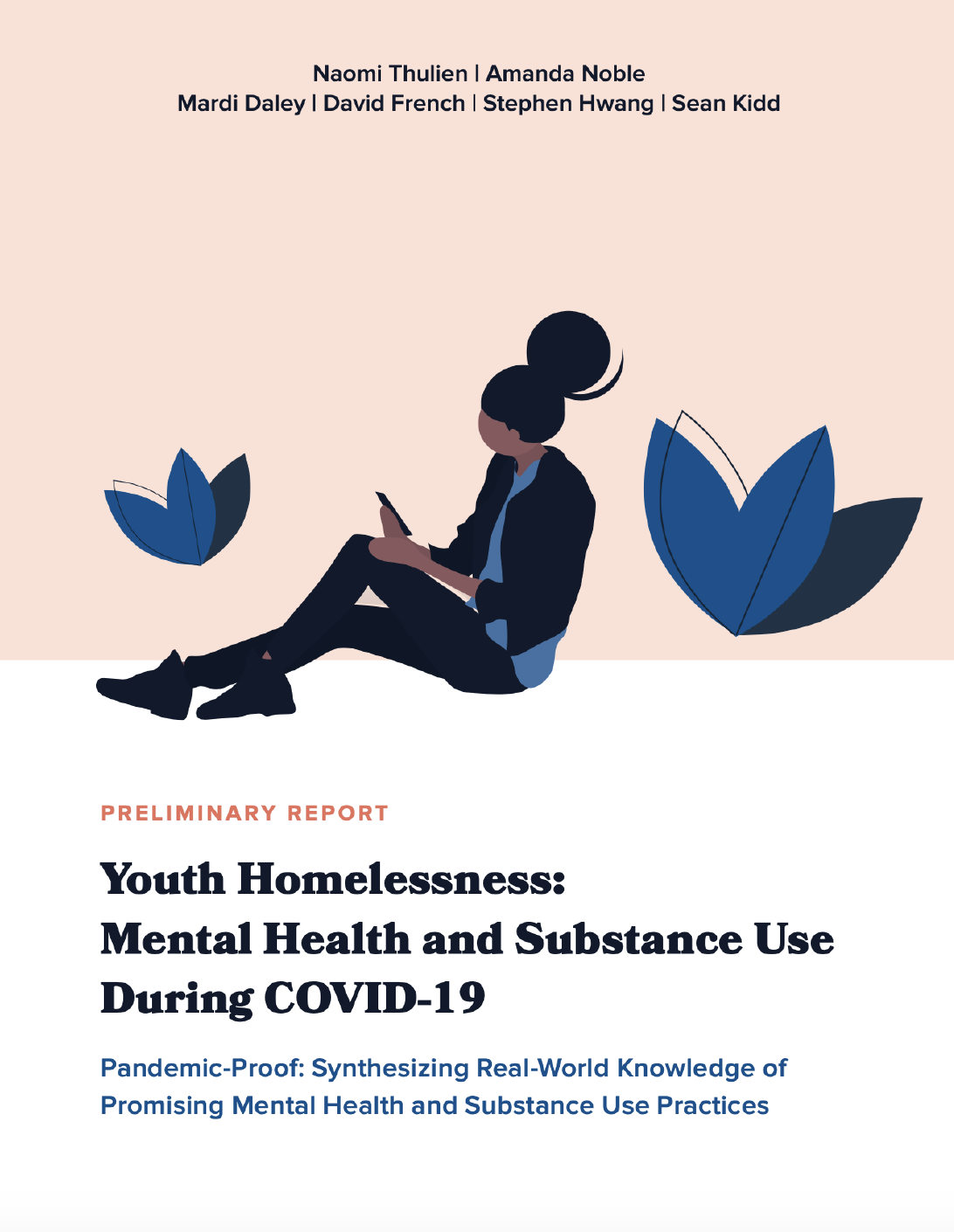How has COVID-19 impacted the mental health and substance use patterns of young people who are experiencing or have experienced homelessness? This is one of three questions our team of researchers, knowledge users, and collaborators – including members with lived expertise – is setting out to understand.
Our preliminary findings were gleaned from an electronic survey that was sent to front-line providers across Canada who work with youth (16 – 24 years) who are experiencing or have experienced homelessness. The electronic survey was available from June 10, 2020 – June 17, 2020 and consisted of 26 questions focused on three key areas:
- pandemic impacts on mental health and substance use patterns;
- front-line practice adaptations; and
- promising and transformation approaches.
Our preliminary report represents the perspectives of 188 service providers across Canada. While the majority (80%) of responses came from Ontario, we did have representation from 65 organizations in 36 cities/towns, across nine provinces/territories in Canada.
This blog post is focused on highlighting our preliminary findings on mental health and substance use patterns. Subsequent posts will focus on what we are learning about practice adaptations.
Mental Health Patterns
Providers report the pandemic has had a tremendous impact on the mental health of the young people they serve:
- Over 90% believe youth are experiencing a significant increase/increase in feelings of isolation, loneliness, and boredom
- The majority report anxiety (85%) and depression (75%) has significantly increased/increased
- More than 1/3 (36%) believe there has been a significant increase/increase in suicidal ideation
Despite the perception that young people are struggling with their mental health, the majority of providers (80%) believe the ability to access appropriate mental health supports has been significantly limited/limited. The top three most common places providers report youth are going to access mental health services are: online (63%), hospitals (42%), and emergency shelters (36%) (providers could select more than one option).
Substance Use Patterns
Similar to mental health, providers believe the pandemic has had a negative impact on substance use patterns:
- The majority (69%) report a significant increase/increase in substance use
- More than 1/3 (37%) believe there has been a significant increase/increase in overdoses
- Almost half (46%) report access to addiction-related supports such as group meetings has significantly decreased/decreased
It is interesting to note that a large number of providers are unsure if the young people they serve have access to appropriate harm reduction supports such as supervised injection sites (51% unsure) and safe supply or substitution (42% unsure).
Disproportionate Impacts
Some providers shared that worrisome changes in mental health and substance use patterns seem to be disproportionately impacting young people from groups that have historically faced additional oppression. For example, young people who are Indigenous, come from racialized communities, and/or identify as 2SLGBTQ (two-spirit, lesbian, gay, bisexual, transgender, and queer).
“Individuals who identify within oppressed groups face increased barriers for accessing and having resources for support when they hold another oppressive identity as a substance user. It’s an added layer of stress and barriers.”
Impact on Providers
The pandemic is having a notable impact on the mental health of service providers. The majority report a significant increase/increase in mental health distress (79%) and burnout (78%). In addition, the majority report a significant increase/increase in staffing burdens (71%) related to significant increases/increases in demands for mental health (65%) and substance use (37%) services.
Discussion
These preliminary findings represent our “first pass” at data related to provider perspectives on mental health and substance use patterns during the COVID-19 pandemic. While we still need to do further analysis and data collection (e.g., follow-up focus groups), there are some important findings that warrant close attention:
- The link between boredom (believed to be experienced by almost all young people) and a host of negative outcomes – including struggles with mental health and substance use – is an emerging area of research in the homelessness literature and merits careful consideration
- Provider perspectives on pandemic-related increases in mental health challenges such as anxiety and depression are consistent with what young people in the broader population are reporting
- More than half of young people are reported to be turning to on-line supports for help; however, the effectiveness of these supports is unclear given rigorous interventions targeting mental health and substance use for youth experiencing homelessness are almost exclusively in-person interventions
- Prior to the pandemic, Canadian youth (15 – 24 years) were the fastest growing population hospitalized for opioid overdose making the reported increase in substance use especially concerning
- The reported increase in overdoses is consisted with emerging findings in provinces like British Columbia, where they recently recorded the highest number of illicit drug overdose deaths in a single month
- There is a notable lack of clarity around where youth are accessing harm reduction supports – especially concerning given the perceived increase in substance use
- The perceived increase in need for supports related to mental health and substance use combined with reports of decreased access and high rates of burnout and mental health distress among providers is a “red flag” which demands careful consideration
Implications
These survey findings highlight important implications specific to mental health and substance use patterns:
- There is a critical need to improve/enhance access to mental health and substance use supports
- Agency/organizational leaders will need to get creative in terms of staffing (enhance staffing, amend old programs, etc.) to facilitate enhanced youth engagement and protect/promote the mental well-being of their employees
- There is an urgent need for research on the effectiveness of current phone/virtual supports, clarity around access to substance use supports, as well as adapting promising in-person interventions
- Policy makers should immediately prioritize investments in agencies/organizations serving young people experiencing homelessness so providers can: a) continue adapting their services using an equity-informed approach (e.g., in-person outreach to the most marginalized and free/affordable devices to access virtual/phone supports) and b) enhance staffing levels to avoid further burnout
Conclusion
So how has COVID-19 impacted the mental health and substance use patterns of young people who are experiencing or have experienced homelessness? Overall, our preliminary analysis indicates young people and providers are struggling to adapt to pandemic-related closures. Nevertheless, there are opportunities to get creative and reimagine our response to the mental health and substance use needs of young people who are experiencing or have experienced homelessness. We look forward to sharing more from our preliminary findings – including promising and potentially transformative front-line practice adaptations – in an upcoming blog.



